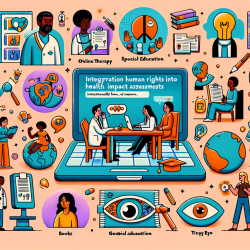Introduction
In the realm of online therapy services, particularly for children, the integration of equitable practices is paramount. The research article, A Path Toward Systemic Equity in Life Cycle Assessment and Decision-Making: Standardizing Sociodemographic Data Practices, offers valuable insights into how practitioners can enhance their services by adopting standardized sociodemographic data practices. This blog explores the implications of this research for online therapy providers, such as TinyEYE, and how these practices can lead to improved outcomes for children.
The Importance of Sociodemographic Data
Sociodemographic data, which includes information on socioeconomic status, race, and ethnicity, is crucial in ensuring that therapy services are equitable and effective. The research emphasizes that incorporating such data into decision-making processes can help meet several United Nations Sustainable Development Goals, such as reducing inequalities and promoting peace and justice.
For online therapy providers, understanding the diverse backgrounds of the children they serve can lead to more tailored and effective interventions. By standardizing data practices, practitioners can ensure that all children receive the support they need, regardless of their background.
Implementing Systemic Equity
The research introduces the concept of systemic equity, which involves the simultaneous administration of resources (distributive equity), policies (procedural equity), and cultural needs (recognitional equity). For online therapy providers, this means:
- Distributive Equity: Ensuring that resources, such as access to technology and therapy sessions, are distributed fairly among all children.
- Procedural Equity: Developing policies that facilitate unbiased and fair decision-making processes.
- Recognitional Equity: Addressing the cultural and emotional needs of children from systematically marginalized groups.
By adopting this framework, online therapy providers can create a more inclusive and supportive environment for all children.
10-Step Process for Standardization
The research outlines a 10-step process for standardizing sociodemographic data practices. This process involves identifying equity-focused professionals, developing preliminary frameworks, and conducting surveys to refine practices. For practitioners, this means actively engaging with diverse stakeholders to ensure that their services are equitable and effective.
Implementing these steps can lead to a more comprehensive understanding of the needs of different children, allowing for more personalized and effective therapy sessions.
Conclusion
Incorporating standardized sociodemographic data practices into online therapy services can significantly enhance the effectiveness and equity of these services. By following the research's framework for systemic equity, practitioners can ensure that all children receive the support they need to thrive. For those interested in delving deeper into the research, please follow this link: A Path Toward Systemic Equity in Life Cycle Assessment and Decision-Making: Standardizing Sociodemographic Data Practices.










